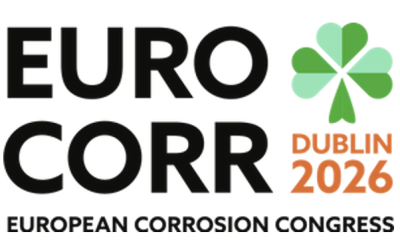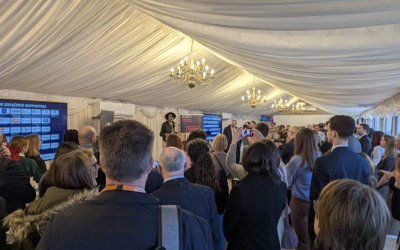The branch held a joint technical meeting with TWI Scottish Branch on 28th September where the speaker, Matthew Beatty from Sonomatic Ltd. discussed “In-service ultrasonic tank floor inspections”.
As described below, Sonomatic have developed an advanced system of robotic instrumentation and associated test procedures which can be used to inspect storage tanks while still in service. The instrumentation can easily navigate tank floors and using ultrasonic techniques (UT), measure the remaining through floor plate thickness, detecting both product side and soil side corrosion. From this, the remaining useful life of the tank can be determined by comparing this with the minimum containment thickness criteria for the vessel.
Desludging of tanks is performed during the measurement process as it is essential that the robot has a clean surface to make the measurement, and obtain good and reliable data. This is by done by either pumping sludge away within the tank, or pumping sludge out of tanks into containers for recycling or filtering and return. The inspection process can extend to survey tank shell walls and roof, annular plates and shell to floor welds using ultrasonics techniques.
Two main ultrasonics techniques are commonly used; (1) Short-range ultrasonics (SRUT) for features such as,
• Tank floor annular plate testing
• Testing concrete coated interfaces
• Testing under pipe supports
• Tank dyke piping interfaces
• Under vessel supports
and (2), Multiplexed phased array UT (PAUT) for the shell to annular plate weld inspection, and to assess the condition of the internal and external weld (for cracking particularly).
Acoustic emission (AE) can be used to scan the floor for active corrosion prior putting the robot into the tank.
The robots deployed for the inspection are dependent on the tank media content and the accessibility. A hydraulic driven robot is used for heavy to light hydrocarbons and a mini ROV swimmer is used mainly in water tanks. Survey robots are fitted with hydraulic pumps and scrappers to remove sludge and sediment and clean the surface ready for ultrasonic work. All robots have safety systems and monitor critical items such as oxygen and nitrogen pressure through the umbilical and can automatically shut down power at alert safety levels.
For inspections, the robot is lowered through a deployment manway using a tripod and winch system to the tank bottom and connected back to the control room through a tailored sealed temporary manway cover. Finally, the tank is purged and pressurised.
The ultrasonic probes used have a range of diameters from 8mm up to 300mm total coverage and are typically arranged in an array of around 30 probes which speeds up the scanning process and makes data more reliable.
A case study was presented of a detailed in-service inspection of an 80 metre diameter tank with known corrosion. Acoustic emission was used first to check 100% of the tank for ongoing corrosion signs. With the robot deployed the sludge was displaced by suction pump and a rubber scraper to remove surface sludge.This inspection used a total of 521 scans, representing 5% coverage of tank base. The sampling methods and statistical analysis allow for limited coverage inspection so there is no need to inspect 100% of features. With the in-built ultrasonics, in this instance which used 8 transducers with amplitude variation across each transducer, the min thickness found was 4.8mm compared with the nominal thickness of 7mm, which gave an estimated remaining life of 2 years before an out of service inspection was required. After shutdown 3 years later, the floor thickness was confirmed to be 2.20 mm versus a predicted 2.53mm from in-service inspection, a <5% difference between the two methodologies which is considered an accurate and successful prediction compared with manually performed UT readings.
The accuracy of the predictive system using the in-service data illustrated that robotic inspection of the tank floor is a viable alternative to costly shutdown and out-of-service inspection.
The branch October meeting featured an interesting online talk from Professor Y. Frank Cheng. University of Calgary (UoC), entitled “Internal corrosion of pipelines: mechanisms, modelling and management”.
Internal corrosion of pipelines is a complex phenomenon, and the complexity arises from the fact that multiple chemical and electrochemical reactions occur simultaneously with numerous interrelated factors affecting the corrosion processes. A fundamental understanding of the phenomenon is essential to modelling, prediction and management of the corrosion processes, providing recommendations to industry for improved pipeline integrity management.
Currently, pipelines for oil and natural gas are the conduit for around 55% of energy transport and, despite the rise of renewables and net-zero targets, they will still be utilised for a similar amount of energy transportation when H2, CO2 and biogas gain in popularity. For oil and gas transport, the upstream ‘gathering’ pipelines which run from production to the upstream processing plants are the subject of interest here. Of course, the corrosion issues in different sectors of the pipeline system can be very different due to the product being carried and the internal environment. In upstream gathering lines within Alberta in 2019, 46% of the corrosion issues were deemed to be due to internal corrosion alone.
Multiple factors affect the corrosion process, including fluid chemistry, operating conditions and pipe geometry. To deal with the complex issues it is important that computer models take into consideration each of these factors, and study each of the key parameters, reaction chemistry, fluid hydrodynamics and configuration, so as to produce a workable model which will realistically predict the corrosion outcome.
The UoC initially developed a thermodynamic model to determine the electrochemical anodic and cathodic reactions occurring during internal corrosion of pipelines under given conditions, and the chemical reactions (for instance CO2) occurring during electrochemical cathodic (evolution of gas) and anodic reactions (at the steel oxidation). The internal corrosion involves the formation of iron carbonate scale on the surface which changes the corrosion rate. When H2S is also introduced there are competing reactions with CO2, which further complicate the outcome.
For the chemical reactions they derived the reaction equilibrium constants and for the electrochemical reactions calculated the standard electrode potentials by Gibbs free energy and determined partial reaction potentials by the Nernst equation.
Fluid hydrodynamics plays a critical role in influencing corrosion, so studies were conducted by fitting electrodes flush with the inside pipe walls at straight and angled positions to measure corrosion rate with flow and with impingement angle to the pipe wall. Other effects that were incorporated in the flow model were the inhibitive effect of the hydrocarbon oil phase and the erosive effect of inorganic sand and solids.
Another consideration for UoC modelling was the organic acid that is always part of the fluid in upstream hydrocarbon pipelines and which will attack the iron carbonate film which readily forms on the inner walls of the pipe. The scale builds faster with higher CO2 and temperature but, when the FeCO3 scale is broken locally at a defect, this leads to pitting corrosion under the scale and can lead to accelerated attack and leaks in pipeline walls. Pitting corrosion also occurs under sand layers which settle on the pipe floor from the high upstream sand concentration in the oil sand.
The final and possibly greatest issue in oil pipeline corrosion was determined as internal microbial corrosion which is believed to be responsible for ~ 40% of all internal corrosion events in pipelines. Microbial Corrosion occurs under any deposit mixture of petroleum sludge, sands, water microorganisms and corrosion. Internal operating environments encourage growth of the microbial population products. However, in the case of gas pipelines a thin layer of water condensate occurs on the chilled wall of the pipe which makes the formation of biofilms difficult and the deposit of corrosion films more favourable, so there is a competition between the two effects.
Several predictive corrosion models have been developed from the experimental studies of parameters and mathematical relationships, and these UoC models can assist in identifying critical corrosion locations, especially pitting and erosive corrosion on a long-distance pipeline, then predict the pitting corrosion rate and pitting growth rate, however corrosion mitigation and control by operators should not rely on inhibitors and biocides as they are not a totally satisfactory solution and periodic pigging is still required as main method of control in removing and reducing deposits and sludge.
This very comprehensive presentation generated much interest from the audience and many questions that were expertly responded to by the author.
Slides of technical papers for Aberdeen branch events, along with their respective Q&A’s can be found at, https://sites.google.com/site/icorrabz/ and also at Aberdeen Branch – Institute of Corrosion (icorr.org) under Local Technical Programme. A library of event recordings may also be found at:
https://www.youtube.com/results?search_query=ICorr+Aberdeen



